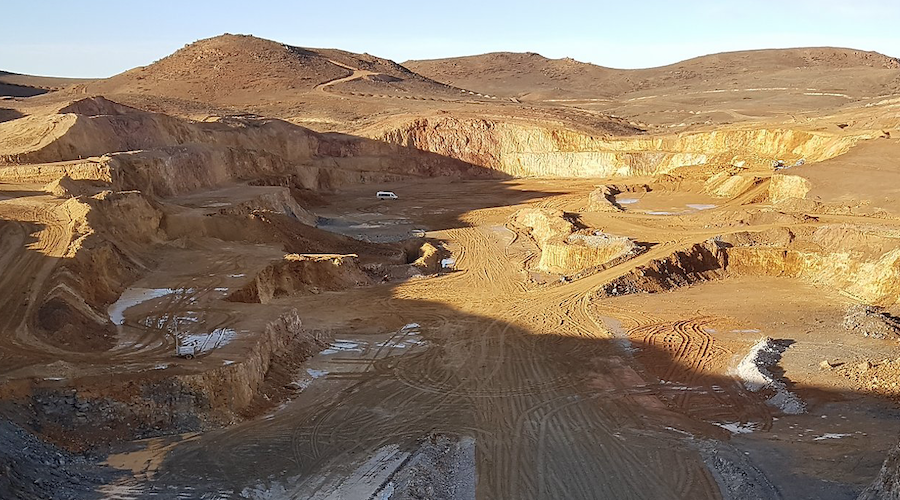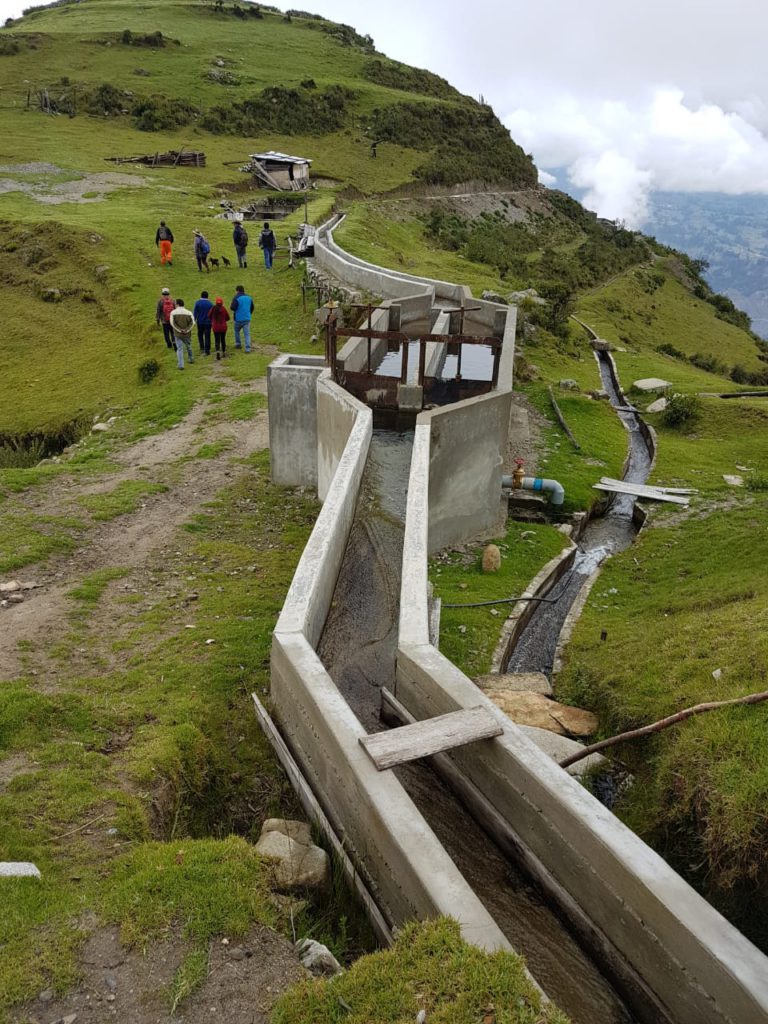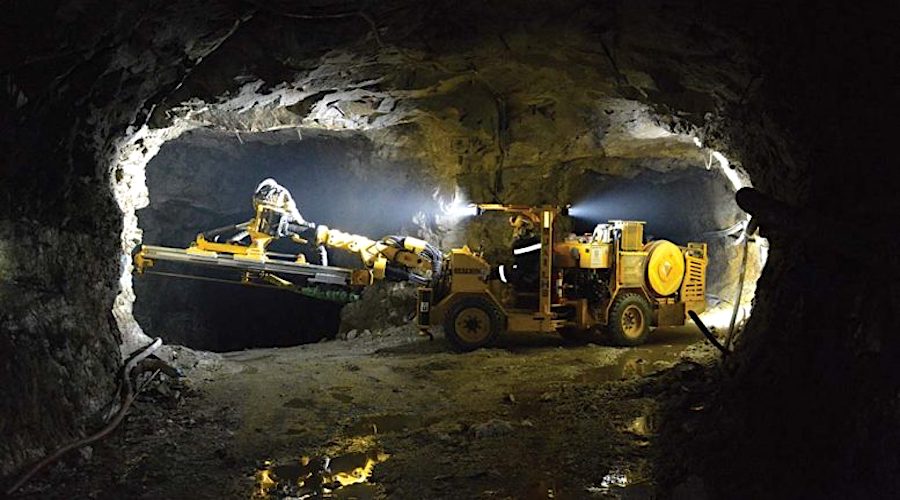Snapshot: Eight Canadian companies exploring in South America
Altar Central and Altar East contain 13.2 billion lb. copper equivalent at 0.50% copper equivalent in measured and indicated resources. There is another 1.9 billion lb. at 0.47% in the inferred resource.

The estimate has total measured and indicated resources of 1.2 billion tonnes grading 0.43% copper, 0.09 gram gold per tonne, and 1.0 gram silver per tonne. There are 11.4 billion lb. copper, 3.4 million oz. gold, and 38.6 million oz. silver in this portion of the deposit. The inferred resource is 198.2 million tonnes grading 0.42% copper, 0.06 gram gold, and 0.80 gram silver, containing 1.75 billion lb copper, 400,000 oz. gold, and 4.8 million oz. silver.
The Altar Central and East deposits both have a supergene and a hypogene component, with a ratio of about 1:3, respectively, in the measured and indicated resource. The presence of supergene ore gives the project a potential, low cost starter operation that contains 2.96 billion lb. copper and 700,000 oz. gold.
The company’s QDM-Radio deposit sits about 2,500 metres to the west. The supergene portion of the QDM-Radio deposit is thought to contain 590,000 oz. gold-equivalent at 0.91 gram gold-equivalent per tonne in measured and indicated resources, plus 30,000 oz. at 0.70 gram gold-equivalent in the inferred resource. The detailed numbers include 20.0 million tonnes grading 0.78 gram gold per tonne, 3.59 grams silver per tonne, and 0.06% copper, containing 500,000 oz. gold, 2.33 million oz. silver, 26 million lb. copper. The inferred portion has 1.2 million tonnes at 0.58 gram gold, 5.34 grams silver, and 0.03% copper for 20,000 oz. gold, 210,000 oz. silver, and 1.0 million lb. copper.
The deeper portion of the QDM (Radio) porphyry deposit has insufficient drilling to estimate a resource, but there appears to be significant potential there.
The Altar property has a considerable exploration upside, too, says Aldebaran. There is a QDM West zone, a Gap zone between QDM and Altar Central and East, and an Altar East East zone.
The Altar East East deposit was discovered in the mid-1990s. Aldebaran took a five-year, 80% option from former owner Sibanye-Stillwater in 2018. After examining historic work at the property, Aldebaran updated the resources this year.
The company has a market capitalization of C$79 million.
Altamira Gold
Altamira Gold (TSXV: ALTA; US-OTC: EQTRF) is drilling three 100%-owned gold targets in Brazil. The company has two early stage properties in Mato Grosso state — Santa Helena (gold-copper) and Apiacas (gold). The more advanced project is Cajueiro, which crosses the boundary between Mato Grosso and Para states. This is a former mine that produced over 250,000 oz. gold in the 1980s and 1990s. Altamira is expanding the resources with the goal of near-term production.
A 43-101 report from 2019 put Cajueiro’s indicated resources at 5.6 million tonnes grading 1.02 grams gold per tonne, containing 185,000 ounces of gold. The inferred resource was estimated at 12.7 million tonnes grading 1.26 grams gold, containing 515,000 ounces. The resource is open at depth and long strike, and there are untested gold-in-soil anomalies.

Metallurgical testing in 2016 returned recoveries of between 93.7% and 96.2% using gravity and cyanide leaching. Tests continue.
Altamira says it is ready to begin construction of a 1,000-tonne per day processing plant for oxide ore. The company estimates $6 million for both the plant and mine development. The trial mining and environmental licences are in place. Initial ore is to be mined from the higher grade oxide material at the project’s Baldo and Centre zones.
The company is currently testing the Maria Bonita target at Cajueiro where a major gold-in-soil anomaly was discovered. This target is 4.5 km west of the Cajueiro resource area, and soil samples have had even higher values — up to 3.1 grams in soils —than at Cajueiro.
The Apiacas property is situated in the historic Alta Floresta Belt, one of Brazil’s largest placer gold camps, which has produced about 1 million oz. of gold.Disseminated gold mineralization has been traced over a 4 x 1 km area. Surface sampling has confirmed the presence of four high-grade vein structures at the Mutum target. Historic surface grab samples ran as high as 403.5 grams gold per tonne, and recent ones returned up to 3 metres grading 10.39 grams gold.
The Santa Helena property has a porphyry copper target with peripheral high-grade gold. The target had not been drilled previously, despite surface rock that sampled up to 171.6 grams gold per tonne over several square kilometres.
Altamira has a C$53 million market capitalization.
Cerrado Gold
Cerrado Gold (TSXV: CERT; US-OTC: CERRF) has a wholly owned, producing mine in Argentina’s Santa Cruz province. Minera Don Nicolas (MDN) is a high-grade epithermal open-pit operation capable of producing 45,000 to 55,000 oz. of gold annually.
Currently mining takes place at the La Paloma and Martinetas pits, which are about 30 km apart. Mining is carried out conventionally using drills, trucks and shovels. Run of mine ore is trucked directly to the mill, and low-grade material is stockpiled, perhaps for leaching in the future.

A 1,000 tonne per day processing plant is located at Martinetas. It includes a traditional crushing and grinding circuit followed by carbon-in-leach gold recovery.
The 43-101 report prepared last year put measured and indicated resources at 1.2 million tonnes grading 5.49 grams gold per tonne and 8.37 grams silver per tonne for contained metal of 198,808 oz. gold and 241,903 oz. silver. The inferred resource was 4.7 million tonnes grading 2.33 grams gold and 4.78 grams silver, containing 348,693 oz. gold and 320,118 oz. silver.
Thanks to the cash flow from mine production, Cerrado is exploring for growth opportunities. The most likely is the Monte Do Carmo greenfield discovery in Tocantins state, Brazil. A 17,000-metre drill program is underway to expand the inferred resource, which currently sits at 13.6 million tonnes grading 1.85 grams gold per tonne, containing 813,000 oz. gold. The current drill program is aimed at expanding contained ounces to 1.5 million.
The primary focus is the Serra Alta pit, for which a preliminary economic assessment has been prepared. It carries an after-tax net present value (at a 5% discount rate) of C$432 million and an after-tax internal rate of return of 76.4% with gold at a gold price of $1,550 per ounce. The initial capex is estimated at C$110 million. Average annual production would be 103,000 oz. gold and an average all-in sustaining cost of $498 per oz.
In May, Cerrado reported drilling at the Monte do Carmo project intersected 8.6 metres at 14.1 grams gold and 2.65 metres at 118 grams gold.
Cerrado Gold has a market capitalization of C$102 million.
Eloro Resources
Eloro Resources (TSXV: ELO; US-OTC: ELFFR) has made a major discovery in Bolivia, the Iska Iska silver-tin project in the country’s Potosi department, where silver has been mined since the 16th century and production surpassed an estimated 2.1 billion oz. silver.
The company can earn a 99% interest in the Iska Iska project, and the exploration work is fully permitted.

Iska Iska hosts a silver-tin porphyry-epithermal complex associated with a caldera that is 1.6 x 1.8 km across and at least 1,000 metres deep. The property has some underground development, from which Eloro is conducting drilling. But most of the current program is taking place from the surface.
There are two adits on the property, Huayra Kasa and Santa Barbara. The results that have Eloro accelerating its efforts came in January when the first drill hole in the Santa Barbara breccia pipe intersected 257.5 metres of 129.60 grams silver-equivalent per tonne. The core assayed 29.53 grams silver, 0.08 gram gold, 1.45% zinc, 0.59% lead, 0.08% copper, 0.06% tin, 0.002% indium, 0.006% bismuth, and 0.008% cadmium.
The next target was the Central breccia pipe from which channel sampling returned 166 metres of 442 grams silver, including 56.2 metres of 1,092 grams silver. The first drill hole in the pipe returned multiple intercepts, including 56.2 metres of 196 grams silver-equivalent (105.25 grams silver, 0.10% tin and 0.05 gram gold) and 27.5 metres grading 343 grams silver-equivalent (274 grams silver, 0.16% tin and 0.16 gram gold).
In March, Eloro announced a C$12.9 million bought deal financing, which was then upsized to $21.8 million. That gives the company the funds to accelerate work at Iska Iska.
Eloro has a market capitalization of C$310 million.
Filo Mining
Filo Mining (TSXV: FIL), part of the Lundin Group, is developing the Filo del Sol copper-gold project in the San Juan province of Argentina, close to the border with Chile.
Recent drilling has intersected excellent grades including 858 metres of 0.57% copper, 0.39 grams gold per tonne and 11.1 grams silver per tonne; 1,034 metres of 0.42% copper, 0.32 gram gold and 3.4 grams silver; and 858 meters of 0.89% copper, 0.70 gram gold and 1.80 gram silver.

The project has proven and probable reserves of 259.1 million tonnes grading 0.39% copper, 0.33 gram gold per tonne and 15.1 grams silver per tonne. Indicated resources are 425.1 million tonnes grading 0.33% copper, 0.32 gram gold and 10.7 gram silver, containing 3.1 billion lb. copper, 4.4 million oz. gold, and 146.7 million oz. silver. Inferred resources total 175.1 million tonnes at 0.27% copper, 0.33 gram gold, and 6.2 grams silver, or 1.1 billion lb. contained copper, 1.8 million oz. gold and 34.8 million oz. silver.
A prefeasibility study released in January 2019 outlined an open pit and heap leaching project. Using metal prices of $3 per lb. copper, $1,300 per oz. gold and $20 per oz. silver, Filo del Sol has a mine life, including stripping, of 14 years, and initial capex of $1.27 billion, plus $217 million for sustaining capital and $51 million for closure costs. According to the study, the proposed mine would deliver an after-tax net present value of $1.28 billion, after-tax internal rate of return of 23%, and a payback of 3.4 years. Average annual production would be 67,000 tonnes copper, 159,000 oz. gold and 8.6 million oz. silver at cash costs of $1.23 per lb. copper-equivalent.
In the first half of 2021, Filo has already discovered two new zones of mineralization. In April it reported a new oxide gold discovery 1,500 metres north of the Filo del Sol deposit. The silver zone was also extended to the north, making the total length 2,050 metres. And in May, the company reported the discovery of a significant new zone of high-grade copper-gold-silver mineralization.
Filo has a market capitalization of C$1 billion.
Gran Colombia Gold
In 2010 Gran Colombia Gold (TSX: GCM; US-OTC: TPRFF) took over the high-grade Segovia gold operations in the region of Antioquia, Colombia. These mines have been in continuous operation for over 150 years, producing an estimated 5 million oz. gold during that time. At an average grade of 14.5 grams gold per tonne, the Segovia mines rate as some of the world’s richest.
The Segovia operation includes the El Silencio, Providencia and Sandra K underground mines and the Maria Dama processing plant. Along with the Carla project, the measured and indicated resources are 4.0 million tonnes grading 11.2 grams gold per tonne containing 1.4 million ounces. The inferred resource is 3.7 million tonnes at 10.3 grams gold and containing 1.2 million ounces.

Gran Colombia mines on only three of 27 known veins on the property, so drilling continues at Segovia. The opportunities are plentiful both for greenfield and brownfield discoveries, the company says.
The Maria Dama plant has a throughput of 1,500 tonnes per day and expansion to 2,000 tonnes per day is possible. The flowsheet includes crushing, grinding, gravity concentration, gold flotation, cyanidation of the float concentrate, Merrill-Crowe precipitation followed by refining to produce doré bars.
An interesting facet of mining at Segovia is Gran Colombia’s support of artisanal miners on its property. Over 50 third-parties have been given permission to mine designated areas, and the company pays for recovered gold at a fixed price. Gran Colombia provides health and safety training for these miners and processes their output.
Segovia production is predicted to rise to between 200,000 and 220,000 oz. gold in 2021, up from 196,362 oz. last year.
Gran Colombia’s executives have set out to create a mid-tier Latin American gold producer with the acquisition of Gold X. The company currently holds 18% of Gold X shares, but has offered to acquire the remainder in an all-share deal.
Chief among the assets of Gold X is the Toroparu exploration gold project in Guyana. A 2013 preliminary economic assessment outlined a 24-year mine life with production of 1.5 million oz. gold in doré during the first 10 years of operation. The acquisition is expected to close in late May or early June.
Gran Colombia has a market capitalization of C$316.4 million.
Luminex Resources
Luminex Resources (TSXV: LR; US-OTC: LUMIF) is moving its Condor gold-copper project in Ecuador toward a preliminary economic assessment. The 90%-owned project is located in Zamora Chinchipe state, 30 km south of Lundin Gold’s (TSX: LUG) Fruta Del Norte gold mine.
Luminex was a spin-out of Lumina Gold (TSXV: LUM) and created in 2018 to hold the Condor property. Previous owners spent $40 million on exploration from 1993 to 2016, and they located five deposits. The Condor project has indicated resources of 72.1 million tonnes grading 0.67 gram gold per tonne and 4.2 grams silver per tonne for 1.2 million oz. of contained gold and 9.7 million oz. silver. The inferred portion is 169.6 million tonnes grading 0.66 gram gold and 2.9 grams silver, containing 3.6 million oz. gold and 16.0 million oz. silver.

The company expects to release a PEA on the project in June that will include four deposits — an underground operation at Camp and open pits at Cuyes, Soledad and Enma. A 25,000 tonne-per-day plant is planned. In the future, the Prometedor and Santa Barbara deposits could be incorporated into the mining plan.
Luminex has two earn-in agreements on nearby properties. Anglo American (LSE: AAL) can earn a 60% interest in the Pegasus A and B properties by investing $50 million from 2018 to 2024. The other earn-in is with BHP (NYSE: BHP; LSE: BHP; ASX: BHP) for the Tarqui property. BHP can earn a 60% stake in the project by spending $35 million between 2019 and 2025.
Luminex has a market capitalization of C$1.7 billion.
With three operating underground mines in two countries, Sierra Metals (TSX: SMT; NYSE-AM: SMTS) still maintains an active exploration program. All three mines are on track to increase production and decrease costs this year, compared to 2020.
The company derives about 60% of its revenue from its 100%-owned flagship Yauricocha copper-zinc mine in Peru. The mine has been in continuous operation since 1948. Last year it produced 75.1 million lb. copper-equivalent at an all-in sustaining cost of $2.11 per lb. copper-equivalent sold. The property has measured and indicated resources (including reserves) of 15.9 million tonnes grading 1.18% copper, 2.22% zinc, 0.62% lead, 44 grams silver per tonne, and 0.53 gram gold per tonne. The inferred resource measures 11.6 million tonnes at 1.40% copper, 0.95% zinc, 0.31% lead, 27.5 grams silver, and 0.45 grams gold.

Its 100%-owned Bolivar underground copper-gold mine in Mexico produced 35.8 million lb. copper-equivalent in 2020 and contributed 33% to Sierra’s revenues. The all-in sustaining cost was US$1.88 per lb. copper-equivalent sold. Measured and indicated resources (including reserves) stand at 19.4 million tonnes grading 0.21 gram gold, 0.77% copper and 15.1 grams silver. The inferred resource is 21.4 million tonnes at 0.21 gram gold, 0.78% copper and 14.2 grams silver.
New discoveries at Bolivar offer opportunity to expand production. The Bolivar West Extension has an average in situ grade of 2.09% copper-equivalent with an average true width of 8.2 metres. The Bolivar West zone has an in situ grade of 2.55% copper-equivalent with an average true width of 9.1 metres. Ramps are under development to Bolivar Northwest and Cineguita so that these zones can be mined in the future.
Sierra Metals also owns 82% of the underground Cusi silver mine in Mexico. It contributed only 7% to the company’s revenues last year, but growth is planned. This operation produced 998,000 oz. silver-equivalent in 2020 at AISCs of US$25.26 per oz. silver-equivalent sold. It has measured and indicated resources of 5.4 million tonnes grading 182 grams silver, 0.49% lead, 0.58% zinc, and 0.12 gram gold. The inferred portion is 4.9 million tonnes at 146.0 grams silver, 0.43% lead, 0.69% zinc, and 0.18 gram gold. The high-grade silver vein system recently discovered during development work in the mine has the company thinking of expansion.
A preliminary economic assessment was released for Cusi in November 2020. It examined boosting the current 1,000 tonne-per- day mining and milling rate to at least 1,200 tonnes per day. The mill flowsheet is conventional, including crushing, grinding, flotation, dewatering of final concentrate, and a tailings management facility (TMF).
The capital cost of expansion includes $46.6 million for mine development and $17.6 million for TMF improvements. Sustaining costs would total $45.6 million through 2035. The base case predicts a 16-year mine that would have an after-tax net profit value (at a 5% discount rate) of C$64 million.
The PEA also examined the possibility of expansion to 2,400, 3,000 and 3,500 tonnes per day.
Sierra Metals has a market capitalization of C$672 million.
(This article first appeared in The Northern Miner)



